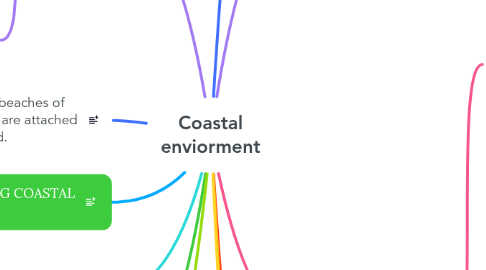
1. coastines
1.1. A concordant coastline is where the same rock runs along the length of the coast. Concordant coastlines tend to have fewer bays and headlands.
1.1.1. West cork coast in Ireland. Rock meets sea in 90degree bands, weak rocks eroded here creating narrow bays.
1.2. A discordant coastline is a coastline where the geology alternates between strata (or bands) of hard rock and soft rock.
1.2.1. Lulworth cove, Dorset. One type of rock . In Dorset hard Portland limestone and resistant purbeck beds protect soft rock behind. In some areas marine erosion has broken through and eroded wide caves behind, behind this is more resistant rock, chalk.
1.3. chalk and limestone: hard rock clay and sand: soft rock.
2. spits are long narrow beaches of sand and shingle that are attached to the land of one end.
2.1. if a spit develops a bay, it may form two headlands and link them together to form a bar.
3. FACTORS AFFECTING COASTAL ENVIORMENTS
4. primary and second data
4.1. Primary: annotated field sketch
4.1.1. secondary data: old maps/google maps (satelight pictures) or pictures from others. data could be unaccurate or bias.
5. What we use to measure stuff
5.1. to measure sediment: calipers
5.1.1. to measure the gradient of a beach: a clinometre and ranging poles
5.1.1.1. to measure lsd: oranges
6. geographic enquiry for coastal enviorments: Coastal management is not required at Dalawella beach due to natural features.
6.1. two types of data collection methods you used during your enquiry:
7. coastal processes
7.1. hydraulic action: when force of the waves hit cliffs, focring pockets of air into cracks and services.
7.2. abrasion: this is caused by waves picking up stones and hurling them at cliffs and so wearing the cliff away
7.2.1. attrition is the process whereby the material carried by the waves become rounded and smaller over time as it collides with other material
7.3. corrosion (solution): the dissolving of rocks by sea water.
7.4. .When the wind blows over the sea, it creates waves. The size and energy of the wave depends on certain factors: the fetch - how far the wave has travelled - the strength of the wind - how long the wind has been blowing for
7.4.1. longshore drift: The process begins with the wind moving in a direction and waves moving in the same direction (1) pick up any material with their swash and move it up the coast (1) this same material is transported down the beach in the backwash due to gravity (1).
8. Types of weathering
8.1. weathering: breaking of rocks which is caused freeze-thaw and the growth of salt crystals, by acid rain and by the growth of plant roots.
8.1.1. Freeze-thaw weathering: occurs when rocks are porous (contain holes) or permeable (allow water to pass through). steps: Water enters cracks in the rock. When temperatures drop, the water freezes and expands causing the crack to widen. The ice melts and water makes its way deeper into the cracks. The process repeats itself until the rock splits entirely.
8.1.1.1. chemical weathering: rainwater and seawater can be a weak acid. If a coastline is made up of rocks such a limestone or chalk, overtime it can be dissolved by the acid in water.
8.1.1.2. biological weathering: Roots burrow down, once it gets bigger it weakens the structure of the rock until it breaks away.
9. erosional landforms
9.1. headland: surrounded by water on three sides
9.1.1. caves, arches, stacks and stumps form on the sides of headlands as a result of constant attack on the headlands rocks by destructive waves.
9.2. bays: surrounded by land on three sides
9.2.1. Caves, arches, stacks and stumps are erosional features that are commonly found on a headland
9.2.2. Cracks are formed in the headland through the erosional processes of hydraulic action and abrasion.
9.2.3. As the waves continue to grind away at the crack, it begins to open up to form a cave.
9.2.4. The cave becomes larger and eventually breaks through the headland to form an arch.
9.2.5. The base of the arch continually becomes wider through further erosion, until its roof becomes too heavy and collapses into the sea. This leaves a stack (an isolated column of rock). An example of a Welsh stack can be found at Stack Rocks, Pembrokeshire.
9.2.6. The stack is undercut at the base until it collapses to form a stump.
